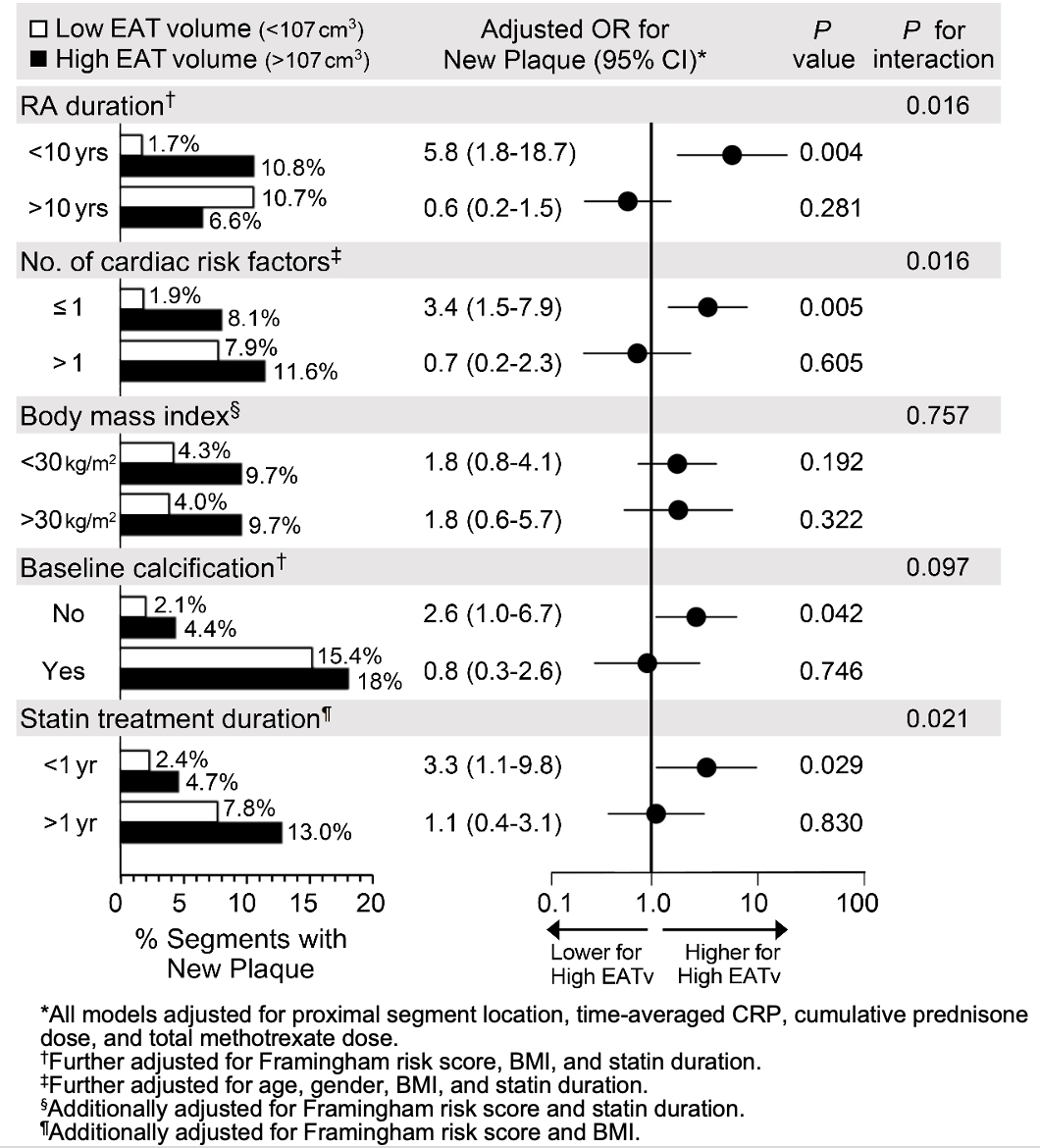Session Information
Session Type: Poster Session A
Session Time: 8:30AM-10:30AM
Background/Purpose: Epicardial adipose tissue volume (EATv) predicts coronary atherosclerosis presence, progression and cardiovascular events in general patients. We recently reported that EATv associated with greater subclinical coronary plaque burden, noncalcified plaque presence and vulnerable plaque characteristics in patients with rheumatoid arthritis (RA). The relationship was stronger in patients without traditional cardiac risk factors, who were not obese and had lower disease duration. We here evaluate the role of EATv on long-term coronary plaque progression and moderators of the association between EATv and plaque formation.
Methods: : This single center observational cohort study included 100 patients without cardiovascular disease who underwent computed tomography angiography for evaluation of EATv and coronary atherosclerosis at baseline and 6.9±0.3 years later, to evaluate plaque progression. New plaque formation in segments without plaque at baseline was the main outcome. Robust multivariable logistic regression evaluated the effect of high versus low EATv (based on median) on likelihood of new plaque formation, accounting for clustering of segments within patients. Potential moderator effects of prespecified predictors were also assessed.
Results: High EATv ( >107 cm3) predicted new plaque formation in segments without baseline plaque (OR 2.77 [95% CI 1.43-5.37], p= 0.003); however, significance was lost in the multivariable model. Importantly, high EATv associated with formation of higher-risk noncalcified and partially calcified plaque after adjusting for Framingham D’Agostino risk score, obesity, segment location, time-averaged CRP, duration of bDMARD and statin treatment and cumulative prednisone dose (adjusted OR 2.57 [95% CI 1.02-6.48], p= 0.045). RA duration (< 10 versus >10 years), cardiac risk factor burden ( 1 versus >1), presence of partially/ fully calcified plaque in other coronary segments at baseline, and statin exposure ( 1 versus >1 year, based on median) moderated the effect of EATv on all new plaque formation (all p for interaction 0.021). Specifically, high EATv predicted new plaque formation in patients with RA duration < 10 years (adjusted OR 5.75 [95% CI 1.77-18.67]), those with 1 cardiac risk factors (adjusted OR 3.40 [95% CI 1.46-7.90]), those without calcification at baseline (adjusted OR 2.65 [95% CI 1.11-6.31]) and those with statin treatment < 1 year (adjusted OR 3.33 [95% CI 1.13-9.77]). This was not the case for patients with RA >10 years, 1 cardiac risk factors, calcification at baseline and statin treatment >1 year (figure 1).
Conclusion: High baseline EATv independently predicted future higher-risk non- and partially calcified coronary plaque in RA. Moreover, it conditionally promoted new plaque formation overall in patients with earlier disease, low cardiac risk factor burden, who had little or no atherosclerosis at baseline and who had limited exposure to statins. These findings indicate the need for a larger prospective evaluation of the role of EATv as a biomarker of coronary atherosclerosis development in RA.
To cite this abstract in AMA style:
Karpouzas G, ormseth s, Hernandez E, Budoff M. Direct and Conditional Effects of Epicardial Adipose Tissue Volume on Coronary Plaque Progression in Rheumatoid Arthritis [abstract]. Arthritis Rheumatol. 2021; 73 (suppl 9). https://acrabstracts.org/abstract/direct-and-conditional-effects-of-epicardial-adipose-tissue-volume-on-coronary-plaque-progression-in-rheumatoid-arthritis/. Accessed .« Back to ACR Convergence 2021
ACR Meeting Abstracts - https://acrabstracts.org/abstract/direct-and-conditional-effects-of-epicardial-adipose-tissue-volume-on-coronary-plaque-progression-in-rheumatoid-arthritis/

